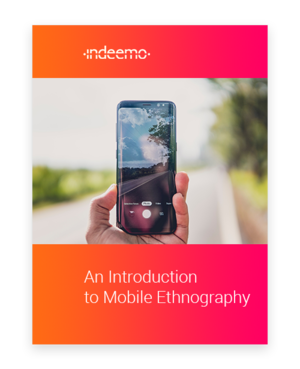Mobile Ethnography White Paper
Learn how Mobile Ethnography can supplement your research projects and generate richer contextual insights for your brands.

This case study explores people’s perceptions, attitudes and motivations towards contactless payment. Interestingly, this study also explores contactless payment in the context of delivery drivers, as we move to a more cashless society post COVID-19.
A second aspect of the study related to functionality and usefulness of the contactless solution e.g. using NFC (Near Field Communication) tags compared to QR (Quick Response) codes).

The client also wanted to understand:
Why do people tip?
What stops people from tipping?
What would enable people to tip - in a food delivery context but also a broader context of bars, restaurants, hairdressers etc.
The client also wanted to understand tipping from the perspective of the “tip receiver”, do they think people’s attitudes towards tipping has changed, and what would make receiving tips easier?
The client also wanted to explore tipping in the context of their service:
Were their instructions clear?
Was the branding appropriate?
What is the best practice to encourage and enable the consumers to tip using contactless technology?

Using a mix of Indeemo’s media upload capability of photos, videos, notes and screenshots, tasks were released to 2 separate groups, the consumers and the drivers, in a scheduled manner over 3 days for each phase.
Initial tasks focused on finding out both consumers and delivery driver attitudes towards tipping and whether there is an emotional aspect to tipping; how this has changed with social distancing and restrictions in restaurants, for food deliveries, hairdressers, barbers, taxi drivers etc.
On day 2, the consumers were then tasked to order food from the participating restaurant and the drivers were tasked with documenting their experience in delivering the food and explaining to the consumers about the new cashless tipping system.
The third day of tasking then focusing on the brand, how well they think it’s displayed and communicated, what settings they could imagine using it in and if they think it works better than traditional tipping.
The interesting aspect of running the project over 2 phases was that the agency and client discovered in Phase 1 was that the concept was not clear to the drivers who were then explaining this to consumers so Phase 1 delivered significant learnings which were then taken on board and adapted into Phase 2 where the driver task list changed a lot, mainly being cut down and simplified even further.

For the majority of drivers, English was their second language and so the project required a clear and not too long task list; they were also mainly answering the tasks while in their cars.
The ability to run the project in 2 phases was invaluable for the moderator as it was their first project ever using a platform like Indeemo so they were able to take their experience from Phase 1, learn from that and incorporate these learnings into Phase 2.
The client was delighted with the level of detail from respondents, and that issues that had not even been anticipated came to light, such as the drivers calling [brand name] an app which it is not yet. They also valued the insights, questions and concerns that came from the consumers around:
Where their money went?
Whether they were charged a fee by tipping?
Advantages of cashless tipping?

Mobile Ethnography offers a comprehensive and adaptable method for gaining insights into the daily activities and habits of participants.
The duration of these projects can vary from several days to up to a year, but usually lasts between one and two weeks.
With years of experience and analysis from numerous projects, we have developed a refined approach to optimizing mobile research, and can swiftly launch your Mobile Ethnography project within just one business day.
We eagerly await the opportunity to discuss further with you.



Learn how Mobile Ethnography can supplement your research projects and generate richer contextual insights for your brands.
